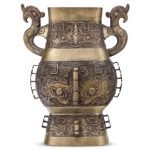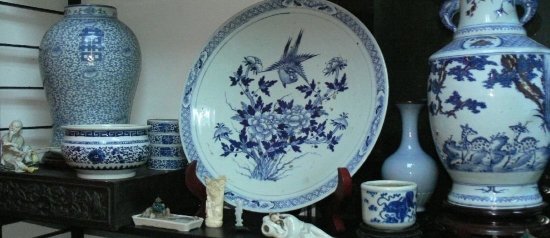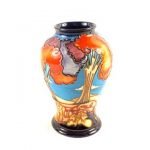I have been collecting Chinese paintings since I moved to Hong Kong in the mid 1980s. First Sotheby’s and then Christie’s opened up small offices in the Central business district and started holding auctions in the downtown hotels. There were a number of galleries and antique dealers in Hollywood Road and elsewhere. I bought my first painting, a wonderful finger-painting of two pine trees in mist by Qian Songyan (1899-1985), from Harold Wong’s Gallery in 1987 and then went on to make further purchases in the auction rooms. It cost me about HK$6,000 (AUD$8,000) and is now worth about HK$150,000 (AUD$200,000). Other works in my modest collection have made similar gains. Those of greater means than I who were at that time buying works by artists such as Huang Binhong (1865-1955), Li Keran (1907-89), Zhang Daqian (1899-1983) and Qi Baishi (1863-1957) have done even better. In these early years there was remarkably little interest in Chinese art among international buyers.
The past twelve months however have seen the Chinese market roar ahead. The sale at Christie’s London in July 2005 of a Yuan dynasty guan for US$30 million (AUD$40 million) made headlines. This was three times the record paid for a Chinese work of art at auction. Bought by London dealer Guiseppe Eskenazi on behalf of a Swiss client, the price was probably too much but even so it represents a dramatic leap. A second guan, which came from the same group of eight that are known to art historians today, albeit slightly less splendid, sold at Christie’s Hong Kong in November for a more reasonable price of US$5 million (AUD$ 6,650,000), this time to a Chinese buyer.
The continuing expansion of the Chinese market can be seen in the recent sale at Sotheby’s in Melbourne on 30 November 2005 of two important Chinese collections. Jane Carnegie was one of the leading figures in the Australian art world, and one of the first Australian dealers to specialise in Asian art. Hans Chey was a wealthy Chinese industrialist whose wife Jocelyn worked for the Australian foreign office in China and pioneered Australian-Chinese relationships. The Cheys, who lived between China, Hong Kong and Australia, were thus uniquely placed to acquire Chinese works of art.
A natural level of recovery after six difficult years since the 1999 Asian financial crisis, exacerbated by the SARS influenza outbreak in 2003, should be expected, however, the true reasons lie in the great economic changes China has made during this period. In 1999 the Chinese government pulled out all the macro-economic stops in order to ride out the regional downturn. Beijing stolidly refused to devalue the Chinese yuan as currencies around the region tumbled. Massive deficit spending on public infrastructure kept domestic demand going and created a new market for beleaguered south-east Asian economies. Foreign direct investment in China surged during these years, not least in the newly privatised property market.
Thrown open to private investment in the early 1990s, the Chinese property market was in a state of collapse by 1999. The Shanghai authorities took the decision to stimulate the property market by allowing local and foreign investors to offset a hundred per cent of their mortgage payments against income taxes. This meant that after fifty years of making landlords suffer for owning land, it was now suddenly a gross error not to own property. The years 2003 to 2005 saw a 250 per cent increase in Shanghai property values.
Furthermore, the state-owned banks were instructed to invest in mortgages nationwide. The Peopleᅰs Bank of China felt that the banks needed to diversify their holdings away from the moribund state-owned industrial sector and towards consumer lending. Between 1992 and 2004 (when the hundred per cent tax allowance was suspended), the rate of private property ownership in Shanghai increased from two per cent to five per cent. Moreover, the eagerness of the banks to extend mortgage loans to fulfil the quotas they had been set enabled astute speculators to raise several loans against the same asset and to diversify their investments into other asset classes. The stock and bond markets in China offer little incentive to invest and so the art market has become a focus of attention.
Art auction houses have existed in China since the early 1990s. At that time the mainland government had begun to note the growing success of Sotheby’s and Christie’s in Hong Kong and felt the necessity to build some local firms to be able eventually to compete by the time of market liberalisation (scheduled for 2008). I was living in Shanghai at the time of the first auctions and attended early attempts by China Guardian in Beijing, Duo Yun Xuan in Shanghai and a plethora of smaller, local firms to hold auctions. What was quite surprising at that early stage was the amount and the variety of material that was available, despite the depredations of the Cultural Revolution. It was a buyer’s paradise.
The material came from three sources: the government warehouses set up during the Cultural Revolution; the stock of the state-owned antique stores, many of which had invested in auction houses, and private collectors both in China and Hong Kong who had managed to hold on to their collections through the bad years of the 1960s and 1970s and felt patriotically inclined to support the emergent Chinese auction houses.
The majority of material sold at that time in China, as now, had been works of art made for the emperors and wealthy classes of the Song, Ming and Qing dynasties. The same period saw massive quantities of tomb material (what is known in China as mingqi) smuggled out of China and retailed to Western and Japanese collectors. This trade continues, but is not the subject of this article.
In those early years, there was only modest local Chinese demand for works of art. Then, at the sixteenth Party Congress in November 2002, the Chinese Communist Party made the unprecedented step of inviting capitalists to join its ranks. The accumulation and display of wealth was respectable for the first time since 1949, flooding the Chinese art market with cash.
The Chinese market has developed with its own peculiar local features. The first of these is the very high sell-through rate. Since returning to China I have attended several auctions in Beijing, Shanghai and Hong Kong and most lots sell. As a certain London auction house expert was overheard to say in Hong Kong: ‘Ten years ago you simply couldn’t move this stuff and now it is all selling over high estimate.’
The second feature, implied above, is that anything sells. For years, issues relating to the authenticity of certain pieces were hotly debated at the previews and uncertain lots were left unsold. Now, almost everything sells. If the item can pass as authentic, the mainland Chinese dealers have a market for it.
The third feature is the added premium paid for Chinese works of art repatriated from overseas and thus stamped with the appropriate Cultural Relics Department seal that can allow the pieces then to be re-exported. The rules governing the export of Chinese antiques are not entirely clear and the safest advice is that arbitration is entirely in the hands of the Cultural Relics Bureau.
The fourth feature is the local aspect of the market that has led painters from Zhejiang, Jiangsu and Shanghai to lead the market, closely followed by the Beijing school. By contrast, the Guangdong school of painting, which was quite sought after a few years ago, has appreciated less than the northern schools, following the relative economic stagnation of the south. Regional demand has led to Beijing auction houses holding previews in Hangzhou, the capital of Zhejiang province, rather than in Shanghai and to the emergence of Nanjing, the capital of Jiangsu province, as an important secondary art market.
What these factors add up to is that a large percentage of the works of art sold at auction in China end up being given as gifts to those officials whose patronage is essential to the newly wealthy class of entrepreneurs. In addition, large sums of money that may have been made in cash over the last few years can be effectively laundered through the art market, while works of art that can be exported provide an effective means of expatriating large sums of money to pay for overseas trips, education, housing and other desirable items.
Does this mean that readers of this article should rush to consign their Chinese works of art to mainland auction houses? That is an option, but certain risks need to be taken into account. The Chinese currency, the RMB, is still not fully convertible. This has not prevented Chinese auction houses from finding methods of paying overseas consigners in US dollars, but these methods are not necessarily completely legitimate and might be challenged.
The Chinese auction market is also extremely crowded with many new houses and great competition for the best consignments. The commingling of funds is widespread on the mainland and bidders at auction are often powerful and slow to pay. Auctioneers observed in action by this writer are of varying quality and sometimes downright incompetent. Consigners should not be overly assured of getting fair treatment.
This might lead one to the conclusion that Sotheby’s and Christie’s in Hong Kong are the best choice for consignments and indeed there is the comfort of the rule of law in Hong Kong, plus the local presence of most major banks. Unfortunately, transaction costs at the major auction houses in Hong Kong are higher than at the Chinese auction houses, and the results, especially for middle-market material, are not as impressive as in China.
Christie’s put a toe in the mainland Chinese market in November 2005 by licensing a local Beijing company, Forever International Auction Company, to conduct a sale of modern and contemporary Chinese paintings using Christie’s brand name. The auction was reasonably successful, but led to Forever having its license revoked in December. It seems that neither the relevant authorities, nor the local auction houses, are interested in having the rules bent to allow international investment into this increasingly lucrative sector of the economy.
The conclusion to take home then is that the Chinese art market is currently a seller’s market across a wide range of categories. Twentieth-century paintings and Yuan to Qing porcelains are in the centre of a raging bull market. Most other categories are being driven up as I write. Whether this market merits a definite ‘sell’ or a ‘hold’ depends on what you have got. In the case of less than remarkable twentieth century paintings the market is a sell. In other areas there are arguments for a longer-term view. The price paid for the guan in London last July, shows that items of exceptional quality still have upside potential.






